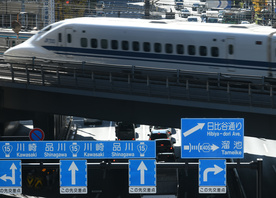Follow in the footsteps of Edo period travellers by walking the beautiful and historic Nakasendo Trail between Tokyo and Kyoto.
Table of contens:
Intro
The beautiful country of Japan is famous for its walking and hiking trails, and there are few more historic than the Nakasendo. This Edo period walking trail connects modern day Tokyo (formerly known as Edo) with Kyoto and includes a wealth of stunning scenery along the way. While Japan’s superb domestic rail network is undoubtedly the best and most cost effective way to get around the country, it’s definitely worth experiencing the landscape on foot too. We’ll tell you everything you need to know about the famous Nakasendo trail, including how to get there, the history behind it, things to see and do along the way, and more. Grab your walking boots (and your JR Pass) and get ready to follow in the footsteps of the ancient Edo travellers on this truly unique and beautiful journey from Tokyo to Kyoto.
What is the Nakasendo Trail?
Nakasendo means ‘Central Mountain Route’ and refers to one of the five routes of the Edo period (1600-1868). It is more than 330 miles long and was one of two trails running from Edo (modern day Tokyo) through the Honshu mountain range and Japanese Alps to Kyoto.
These feudal highways were used by the Shogun as a communications network to help rule the country. Today, this historic trail is made up of contemporary roads and footpaths, but several sections of the original route remain and have been officially named a National Historic Site of Japan. Many of these historic stretches can be explored on foot and offer visitors the chance to step back in time to the Edo period.
The modern day route connects Tokyo and Kyoto and can be traversed in both directions, passing through several prefectures including Saitama, Gunma, Nagano, Gifu, and Shiga. However, when many people refer to walking the Nakasendo trail they are often talking about the historic sections that remain, particularly those in Gifu Prefecture and Nagano Prefecture’s Kiso Valley, where you’ll find charming and picturesque old post towns like Tsumago, Narai, and Magome.

A Brief History of the Nakasendo
The Nakasendo was created during the Edo period as one of five official routes for Shogun Tokugawa Ieyasu to control the country. It was travelled by lords, merchants, pilgrims, monks, samurai and more, including the famous haiku master Matsuo Basho. The five routes, including the Nakasendo, were restored from pre-existing highways and pathways that dated back more than a thousand years by edicts introduced by the Shogun in 1602. As it took several days to complete the 332-mile Nakasendo trail, the route included a number of Juku (rest stations) post towns for travellers to stay overnight. Originally, there were a total of 69 of these stations along the route.
While modern roads and railways eventually reduced the political importance of the Nakasendo, the trail exists today as a scenic journey into Japan’s feudal past. Interestingly, the country’s transition from feudal state to the present day is recounted in a famous novel set along the Nakasendo Trail called ‘Before the Dawn’ by Shimazaki Toson. For more on Japanese literature read our guide to the country’s Famous Writers.
Many of the old post towns along the route have remained unchanged for hundreds of years and offer visitors a genuine chance to step back in time. The trail is also known for winding gently through Japan’s beautiful forested and mountainous landscape, with quaint wooden villages, towns, welcoming inns, and warming hot springs along the way.
As we mentioned above, the 332-mile trail stretches from Edo (modern day Tokyo) to Kyoto. However, the best known, and most popular historic section is in the Kiso Valley between Tsumago and Magome. This 7.7km trail can be travelled by foot and is famously beautiful thanks to its waterfalls, forests, mountain scenery, quaint bridges, and beautifully preserved Japanese towns. You can reach this historic area with your Japan Rail Pass as a day trip from Kyoto or Nagoya. We will have more on how to get there below.
Of course, there are much longer sections of the Nakasendo for the more adventurous. You can start at the Sanjo-Ohashi bridge in Kyoto - one of the historic beginning points of the full trail - through Hikone, on the shores of Lake Biwa, Sekigahara, Hosokute, and Ena before reaching Magome and Tsumago, and continuing onto Kiso-Fukushima, the Kaida Plateau, Narai, and Karuizawa, before finally crossing the Nihonbashi Bridge (the official end of the old highway) and reaching Tokyo. Phew! You’ll definitely need a good long soak in an onsen after all that walking!

Highlights from the Nakasendo Trail
There are lots of famous highlights along the Nakasendo Trail, including both the full 332 mile route and the shorter historic section through the Kiso Valley. Here are our recommendations:
- Okute and the giant cedar tree
Between Hosokute and Ena lies the post town of Okute, at which entrance stands a huge cedar tree that is reportedly more than 1,300 years old.
- Magome
The Magome Pass leads into the Kiso Valley, which is considered by many to be the heart of the Nakasendo Trail. Magome itself is easily one of the most beautiful Edo period post towns (alongside Tsumago). With traditional wooden buildings, museums, Eiheiji temple, Japanese cedar (sugi) forests, and views of the central Japanese alps in the distance, it’s the old Japan of your imagination.
- Tsumago
O-Tsumago is also considered to be one of the best preserved and most picturesque post towns in all of Japan. It’s a real treat for visitors who want to experience the old Japan, and with no telephone poles, electrical lines, or modern conveniences in sight, it really is like stepping back in time. Look out for family-run Ryokan (inns), merchants, and more in this lovely, old-fashioned post town.
- Momosuke suspension bridge
Built in 1922 by Momosuke Fukuzawa and pictured above, this beautiful wooden suspension bridge in Nagiso is a sight to behold.
- Karasawa-no-taki
This stunning 100-metre high waterfall is located on the Kaida Plateau on the way up to Mt. Ontake-san, an active volcano, and a mountain sacred to Japanese Buddhists. It’s also the highest point along the Nakasendo Trail at 1,422 metres.
- Matsumoto Castle
Although a slight deviation from the Nakasendo Trail, this beautiful castle is close enough (and spectacular enough) to justify the extra journey from Nagano or Nagoya. Matsumoto Castle is regarded as one of the most iconic in Japan. Read our guide to Visiting Matsumoto, the Castle in the Japanese Alps for more.
- Karuizawa
For centuries Karuizawa was another post town along this famous route, but today it is a high-end luxury mountain resort town. It is a popular day trip from Tokyo itself, and one of the last stopping off points before the end of the Nakasendo Trail.
How To Get There
Using your JRailPass, you can travel from Kyoto to the historic section of the Nakasendo Trail in the Kiso Valley. Simply take the Hikari or Kodama shinkansen from Kyoto to Nagoya and then transfer to a Shinano Express to Nakatsugawa. You can then take a short bus journey to Magome and the start of your walking trail.

Essential Tips for Walking the Trail
Whether you’re a beginner to walking and hiking, or super experienced, we’ve got you covered with these essential tips for the Nakasendo Trail:
- What should I wear? While this partially depends on when you visit (more on this below) and which section of the trail you decide to explore, it’s generally recommended to pack appropriate footwear for walking and hiking, as well as clothes suitable for variable weather condition i.e., warmer clothes for colder days, lighter clothing for the heat, and waterproofs if it rains. Also, if you’re hiking in summer, consider a wide brim hat to help block out the sun’s rays.
- Rain or shine, bring plenty of water to stay hydrated while walking the Nakasendo. It’s also worthwhile packing high-calorie snacks while out and about, although there are plenty of inns and other places to eat in the main towns on the route.
- When is the best time to walk the Nakasendo Trail? The trail can be hiked throughout the year, so it partially depends on your personal preference. From cherry blossoms in spring, to summer sun, or the golden leaves of autumn, it’s beautiful all year round. You can find out more about Japan’s Seasons by reading our guide to the weather. For further help on when to visit this beautiful country, you can also read our guide on When Is The Best Time To Visit Japan.
- If you’d like to check the local weather before setting off, try the Nakatsugawa Tourist Information centre on +81-(0)573-62-2277. It’s particularly worth asking about the weather if you’re planning to walk between October and April as there could be snow on the trail.
- Where should you stay? There are lots of traditional Ryokan inns with onsen in the vicinity of Tsumago and Magome for that authentic Japanese experience. Ryokan often feature such traditional Japanese staples as shōji and tatami. The experience of ryokan is not limited just to the style of the rooms either. Ryokan often include amenities such as onsen, offer traditional Japanese meals, and observe Japanese household traditions. For more, read our guide to the Best Ryokan in Japan.
- Wifi is essential when exploring on foot. Make sure you invest in a Pocket WiFi device to ensure you stay connected during your adventure. Read our Complete Guide to Portable Wifi in Japan for everything you need to know.
Bonus Recommendations
Whether it’s Edo Period Japan you’re interested in, enjoying outdoor activities while exploring this amazing country, or both, we’ve got lots of related recommendations for you as a bonus.
- Naturally, if you’re interested in the Nakasendo Trail, you might be interested in more walking and hiking elsewhere in Japan. The Futabanosato Walking Trail in Hiroshima is another historic and beautiful route to explore.
- Japan also has plentiful climbing and mountaineering for the more adventurous among you. Read our Guide to Climbing and Hiking Mount Fuji and our Quick Guide to Hiking in Japan for more.
- Another great recommendation for after you’ve completed the trail and arrived in Kyoto would be to continue your adventure by hiking through Kyoto’s northern mountains to Kibune and Kurama.
- As well as walking and hiking, Japan is also a great place to head out on two wheels with some of the best cycle routes in the world, such as the Shimanami Kaido. Find out more in Japan’s Best Cycle Routes.
- Japan’s islands - there are more than 6,000 in total - are also surrounded by beautiful seas, which make for some of the world’s best diving locations. Take a Deep Dive Into Japan for all you need to know. Alongside diving, you can also enjoy a wide range of watersports and beautiful beaches.
- Inland Japan has some of the most rugged and diverse landscapes in the world, from mountains, rivers, and forests, to beaches, islands, rice fields, and more. You’ll find much of this diversity located in the country’s many National Parks (Japan has more than 30) so they make a great destination if you love the outdoors.
- Japan is also famous for having some of the finest ski resorts in the world. If you love skiing, snowboarding, or just snowy weather, then read our Starting Guide to Skiing and Snowboarding in Japan for more.
- Finally, for those with an interest in history and the Edo period, read our guide to exploring Traditional Japan.





